Accelerate > Publications
Search this online library featuring the latest FAO publications, issue papers and briefs which offer up-to-date knowledge and innovative insights for SDG acceleration.
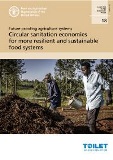
Future proofing agriculture systems - Circular sanitation economies for more resilient and sustainable food systems
2021
The Food and Agriculture Organizationof the United Nations (FAO) and the Toilet Board Coalition (TBC) have collaborated on this piece of work to shine a light on the benefits and rationale for agricultural systems, and the local and national contexts in which they operate, to champion circular sanitation economies and the products coming from them. This paper focuses on discussing the entry points of circular sanitation economies for the agriculture sector ...
Tracking progress on food and agriculture-related SDG indicators 2021
2021
The devastating COVID-19 has already shaken the 2030 Agenda for Sustainable Development to its very core and, as it continues, the full effect on the progress towards the achievement of the Sustainable Development Goals (SDGs) is still to be determined. The High-Level Political Forum noted that the world is “off track” to meeting the SDGs. The COVID-19 pandemic might have pushed an additional 83-132 million into chronic hunger in 2020.

The OECD-FAO Guidance for Responsible Agricultural Supply Chains: Helping achieve the Sustainable Development Goals
2021
This publication describes how the risk-based due diligence framework recommended by the OECD-FAO Guidance for Responsible Agricultural Supply Chains (OECD-FAO Guidance) can help businesses to: identify and address the impacts of operations along their value chains and ensure that their actions and inactions are not undermining the SDGs, and; systematically manage risks and demonstrate their contribution to the SDGs in a measurable way...

Nature-based solutions in agriculture: Sustainable management and conservation of land, water and biodiversity
2021
In recent years, considerable progress has been made in the area of Nature-based Solutions (NbS) that improve ecosystem functions of environments and landscapes affected by agricultural practices and land degradation, while enhancing livelihoods and other social and cultural functions. This has opened up a portfolio of NbS options that offer a pragmatic way forward for simultaneously addressing conservation, ...

Nature-based solutions in agriculture: Project design for securing investment
2021
Today, the global food system drives a ten trillion-dollar economy that connects 7.5 billion consumers and a diverse array of more than 1 billion food producers (farmers, ranchers, pastoralists, and fish harvesters). Approximately one-half of the world’s habitable lands are used for agriculture (Ritchie, 2019). Not surprisingly, the food production system has a massive impact on our planet. As we look to the future, global food demand is set to increase 50%,...

The State of Food and Agriculture 2021 - Making agrifood systems more resilient to shocks and stresses
2021
The COVID-19 pandemic exposed the vulnerability of agrifood systems to shocks and stresses and led to increased global food insecurity and malnutrition. Action is needed to make agrifood systems more resilient, efficient, sustainable and inclusive. The State of Food and Agriculture 2021 presents country-level indicators of the resilience of agrifood systems. The indicators measure the robustness of primary production and food availability, as well as physical and economic access to food...
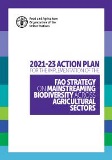
2021-23 Action plan for the implementation of the FAO strategy on mainstreaming biodiversity across agricultural sectors
2021
The action plan for the implementation of the Food and Agriculture Organization of the United Nations strategy on mainstreaming biodiversity across agricultural sectors was approved at the 166th FAO Council in 2021 in view of preparations for the post-2020 global biodiversity framework.
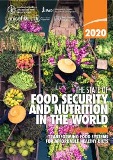
The State of Food Security and Nutrition in the World 2020 - Transforming food systems for affordable healthy diets
2020
Updates for many countries have made it possible to estimate hunger in the world with greater accuracy this year. In particular, newly accessible data enabled the revision of the entire series of undernourishment estimates for China back to 2000, resulting in a substantial downward shift of the series of the number of undernourished in the world.

The State of World Fisheries and Aquaculture 2020 - Sustainability in action
2020
The 2020 edition of The State of World Fisheries and Aquaculture has a particular focus on sustainability. This reflects a number of specific considerations. First, 2020 marks the twenty-fifth anniversary of the Code of Conduct for Responsible Fisheries (the Code). Second, several Sustainable Development Goal indicators mature in 2020...
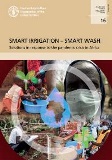
Smart irrigation – Smart wash: Solutions in response to the pandemic crisis in Africa
2020
Uncertainties related to the impacts of COVID-19 on daily life are increasingly growing. Inherent effects have grown beyond the well-defined sphere of health risks and have shocked the livelihood and food security in several countries. Particularly in the poorest countries, the impact is more devastating due to the limited availability of resources to slow down the spread of the disease. These countries require immediate actions to safeguard food security and human health.

How the world's food security depends on biodiversity
2020
As the world population continues to rise, new ways are needed to sustainably increase agricultural production, improve supply chains, reduce food losses and waste, and ensure access to nutritious food for all at all times. This brochure includes the contribution of genetic resources for food and agriculture to food security and to the achievement of relevant sustainable development goals.
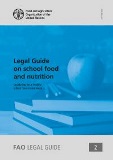
Legal guide on school food and nutrition - Legislating for a healthy school food environment
2020
This Guide promotes a holistic and human rights-based approach to school food and nutrition, in which legislation is an indispensable tool to ensure the sustainability of public policy goals set by a country. In light of international law and standards, it provides practical information and guidance to develop or strengthen national legislation to improve food security and nutrition in schools as well as community development.

The State of Agricultural Commodity Markets 2020 - Agricultural markets and sustainable development: Global value chains, smallholder farmers and digital innovations
2020
The State of Agricultural Commodity Markets 2020 (SOCO 2020) aims to discuss policies and mechanisms that promote sustainable outcomes – economic, social and environmental – in agricultural and food markets, both global and domestic. The analysis is organized along the trends and challenges that lie at the heart of global discussions on trade and development.

FAO Strategy on Mainstreaming Biodiversity across Agricultural Sectors
2020
The FAO strategy on mainstreaming biodiversity was approved at the FAO Conference in 2019, in view of preparations for the post-2020 global biodiversity framework. The Strategy aims to mainstream biodiversity across agricultural sectors at national, regional and international levels in a structured and coherent manner, taking into account national priorities, needs, regulations and policies and country programming frameworks.
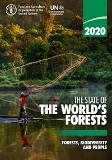
The State of the World’s Forests 2020 - Forests, biodiversity and people
2020
The State of the World’s Forests 2020 assesses progress to date in meeting global targets and goals related to forest biodiversity and examines the effectiveness of policies, actions and approaches, in terms of both conservation and sustainable development outcomes. A series of case studies provide examples of innovative practices that combine conservation and sustainable use of forest biodiversity to create balanced solutions for both people and the planet.

Strengthening sector policies for better food security and nutrition results
2020
This guidance note identifies a number of issues to be taken into account for improving the coherence between food security and food safety policies, indicating how food safety considerations could be integrated into the food security agenda, weighing and optimizing trade-offs, building on synergies and ensuring that different sectors’ objectives are met in a complementary way.

School-based food and nutrition education - A white paper on the current state, principles, challenges and recommendations for low- and middle-income countries
2020
School-based food and nutrition education (SFNE) helps schoolchildren and the school community to achieve lasting improvements in their food practices and outlooks; build the capacity to change and to adapt to external change; and pass on their learning to others. SFNE has also an important role in complementing efforts that are being made globally to improve food environments, and in empowering children and adolescents to become active participants in shaping the food system to be better...

Global Forest Resources Assessment 2020
2020
This assessments, examines the status of, and trends in, forest resources over the period 1990–2020, drawing on the efforts of hundreds of experts worldwide. The production of FRA 2020 also involved collaboration among many partner organizations, thereby reducing the reporting burden on countries, increasing synergies among reporting processes, and improving data consistency.
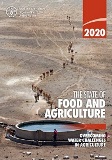
The State of Food and Agriculture 2020 - Overcoming water challenges in agriculture
2020
The State of Food and Agriculture 2020 presents new estimates on the pervasiveness of water scarcity in irrigated agriculture and of water shortages in rainfed agriculture, as well as on the number of people affected. It finds major differences across countries, and also substantial spatial variation within countries.
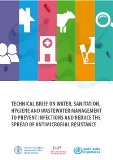
Technical brief on water, sanitation, hygiene and wastewater management to prevent infections and reduce the spread of antimicrobial resistance
2020
This technical brief provides information to inform Water Sanitation and Hygiene (WASH) and wastewater elements within multi-sectoral antimicrobial resistance (AMR) national action plans (NAPs). It includes a summary of evidence and the co-benefits rationale for action in each sector and presents a menu of actions for consideration and refinement in each country context.
Browse by SDG
- SDG1: No Poverty
- SDG2: Zero Hunger
- SDG3: Good Health & Well-being
- SDG4: Quality Education
- SDG5: Gender Equality
- SDG6: Clean Water & Sanitation
- SDG7: Affordable and Clean Energy
- SDG8: Decent Work and Economic Growth
- SDG9: Industry, Innovation and Infrastructure
- SDG10: Reduced Inequalities
- SDG11: Sustainable Cities and Communities
- SDG12: Responsible Consumption and Production
- SDG13: Climate Action
- SDG14: Life Below Water
- SDG15: Life on Land
- SDG16: Peace, Justice and Strong Institutions
- SDG17: Partnerships for the Goals
Browse by Better
Browse by Priority Area
- Innovation for Sustainable Agriculture Production
- Blue Transformation
- One Health
- Small-Scale Producers' Equitable Access to Resources
- Digital Agriculture
- Healthy Diets for All
- Nutrition for the Most Vulnerable
- Safe Food for Everyone
- Reducing Food Loss and Waste
- Transparent Markets and Trade
- Climate Change Mitigating and Adapted Agrifood Systems
- Bioeconomy for Sustainable Food and Agriculture
- Biodiversity and Ecosystem Services for Food and Agriculture
- Achieving Sustainable Urban Food Systems
- Gender Equality and Rural Women's Empowerment
- Inclusive Rural Transformation
- Agriculture and Food Emergencies
- Resilient Agrifood Systems
- Hand-in-Hand Initiative
- Scaling up Investment
